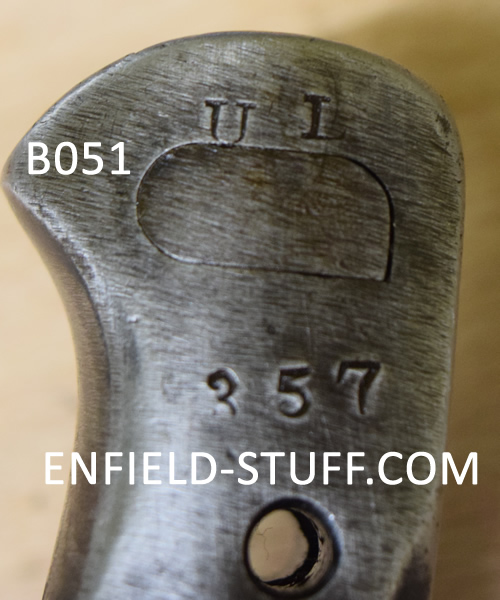 |
Bayonet 051
Pattern of 1907 bayonet; VICKERS 09-1918. With large Vickers-type clearance hole on pommel. Marked UL over 357. ULWAR LANCERS. No arsenal markings. Remington scabbard.
|
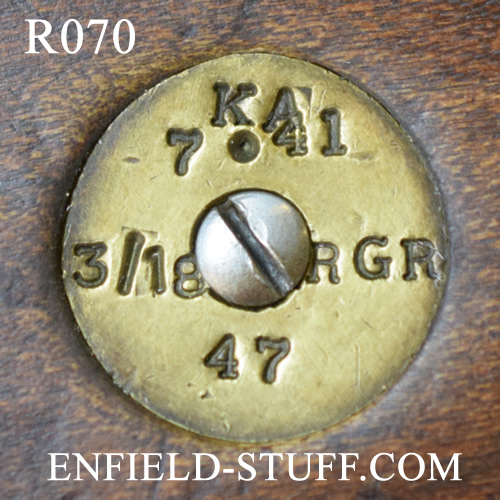 |
Rifle 070
SMLE, No. 1 Mk III* Ishapore 1941. Marked on the disk “3/18 RGR” – 3rd Battalion 18th Royal Garhwal Rifles and dated 1941. The 18th RGR is the post-1922 amalgamation designation of the famous 39th Garhwal Rifles who so distinguished themselves in France in 1914-15. The Garhwalis were always kitted out in the same manner a Gurkhas, as they were Gurkhali speakers from the India-Nepal border area. Overall 90%. Wood VG.
|
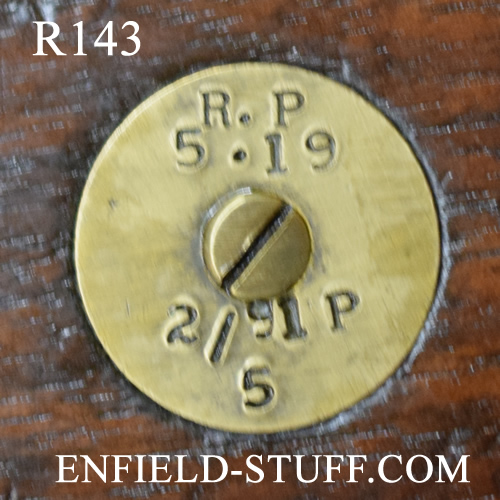 |
Rifle 143
SMLE, No. 1 Mk III. Ishapore 1912. With long range auxiliary sights and windage rear sight. Marked on stock disk "5 19" and "2/91P" indicating that it was in use by the 2nd Battalion of the 91st Punjabis (Light Infantry) in May of 1919. In May of 1919, all battalions of the regiment were on the Northwest Frontier engaged in the 3rd Afghan War. In 1922, the 91st Punjabis was amalgamated and became 2nd Battalion, 8th Punjab Regiment. Overall 90%. Wood VG with typical small dings and dents. Matched (bolt, receiver, barrel, sight, nosecap, and forestock. No import marks. Very rare early Ishapore Mk III with excellent regimental markings.
|
 |
Rifle 157
SMLE, No. 1 Mk III. Ishapore 1909. With long range auxiliary sights and windage rear sight. Marking disk is marked " 1 DM" and "1 / 12" - 1st Battalion, Durham Light Infantry, January 1912. These markings a cancelled and replaced by "1 DG" and "3 15" - 1st Dragoon Guards (often called the "Kaisers Own" since Franz Ferdinand of Austria-Hungary was the Colonel-in-Chief in 1914) and March 1915. Both the 1 DG and the 1 DM were garrisoned in India in August 1914. Upon the outbreak of war, the 1 DG was designated as a part of the IEF, arriving in the lines in Flanders on 5th November 1914. The 1 DM spent the entire war in India while its other battalions served in France and later in Russia. I believe that it is reasonable to surmise that this rifle was removed from the 1 DM at the time of the 1 DG's departure to augment stores for the expeditionary regiments. I suspect that the 1 DM was then equipped with Mk I's or even MLE's. In March of 1915, the 1 DG was in France. Condition is 90%+ finish. Wood is VG- with the usual dings and a couple of small slivers out around the dial sight plate. All matching (receiver, barrel, bolt, sight, nosecap, and forestock). No import marks.
|
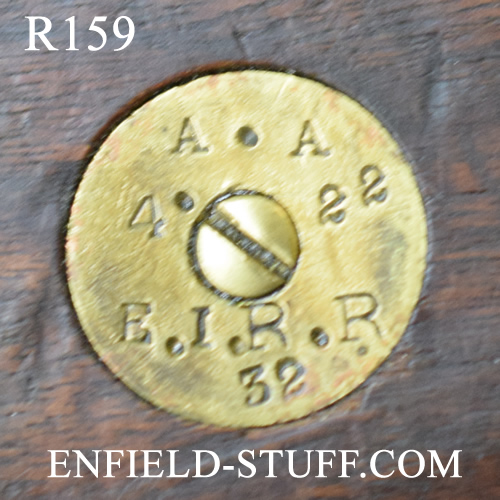 |
Rifle 159
SMLE, No. 1 Mk III*. Standard Small Arms Co. 1918. Marked on disk “EIRR” – East India Railway Regiment and is dated 1921. The EIRR was a “Railway Volunteer” regiment formed in 1869 as the East Indian Railway Volunteer Rifle Corps. Re-designated EIRR in 1920. Overall 90% finish. Wood VG. Matched. No import marks.
|
 |
Rifle 233
SMLE, No. 1 Mk III. Ishapore 1931. Marked on the disk “3/18 RGR” – 3rd Battalion 18th Royal Garhwal Rifles and dated 1941 . The 18th RGR is the post-1922 amalgamation designation of the famous 39th Garhwal Rifles who so distinguished themselves in France in 1914-15 . The Garhwalis were always kitted out in the same manner a Gurkhas, as they were Gurkhali speakers from the India-Nepal border area . Overall 90% . Wood VG.
Lorem ipsum dolor sit amet, consectetur adipiscing elit, sed do eiusmod tempor incididunt ut labore et dolore magna aliqua.
|
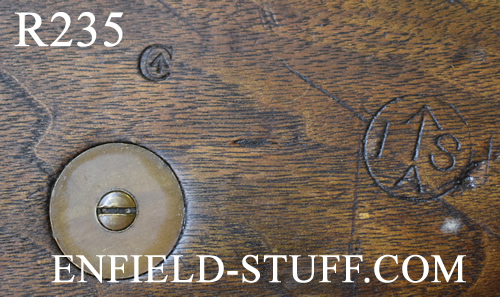 |
Rifle 235
Not unit marked. SMLE No. 1 Mk III* Ishapore 1927. Another conundrum . I cannot decide if this one goes with the Indians or the Canadians . In all respects it is a straight vanilla 1927 Ishapore although it does have a "C" broad arrow property mark in the right side of the buttstock . Marked on both receiver and knox form with the "C" and broad arrow . Stock disk is a standard "AA" (Allahabad Arsenal) with a 1939 date. Go figure . I am really baffled by this one, as the only two places that the Canadian and Indian armies ever were in immediate proximity were in Hong Kong in 1941 (unlikely) and Italy from 1943-1945 . Finish is 90% . Wood is VG with Ishapore cartouches . Matched bolt, barrel, receiver, barrel, sight, nosecap, and forestock . No import marks.
|
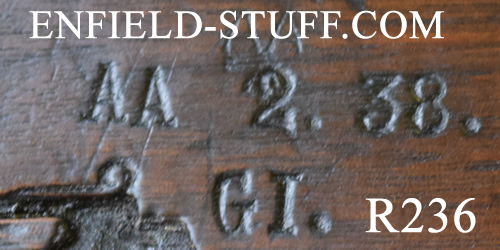 |
Rifle 236
SMLE No. 1 Mk III . BSA 1913 . FTR Ishapore 1935. I know a lot of collectors that will turn up their noses at any rifle marked "EY" - Emergency Use Only . Fine with me - I pick up some interesting rifles this way. Stock is stamped 3 GI - 3rd Gwalior States Infantry and is dated 1938 . The Princely State of Gwalior had five understrength battalions (more like companies) of infantry which - in 1940 - were combined into the 5th Gwalior Infantry. The 4th Infantry also served in Egypt and Palestine during the Great War. Overall 90% finish . Buttstock is VG - with chip out of buttstock at marking disk recess, rest of wood is VG. Matched. Not import marked..
|
 |
Rifle 238-22
.22 Short Rifle No.2 Mk IV* Ishapore 1954 .22 caliber trainer. One of the approximately 35,000 or so purpose-built Ishapore trainers produced between 1953 and 1976 and still in use by the Indian Armed Forces. This one is stamped "CALCUTTA" on the left side of the buttstock indicating Senior Division NCC at Calcutta University. Overall 95% finish. Bore looks unfired - very sharp and bright. Wood is VG+ with all appropriate Ishapore cartouches. Less than 50 of these in the country. Matched. No import marks.
|
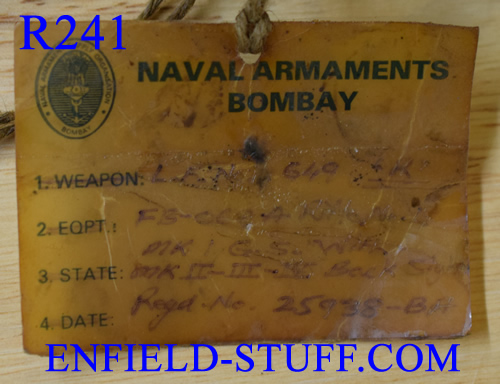 |
Rifle 241
Royal Ordnance Factory - Fazakerley 3/43. A wartime Fazakerley Rifle No.4 Mk I under a formidable amount of cosmolene. There may be some additional service marks waiting to be discovered under all that preservative. In the meantime, it carries a waxed Indian Navy hangtag marked Bombay Naval Stores.
|